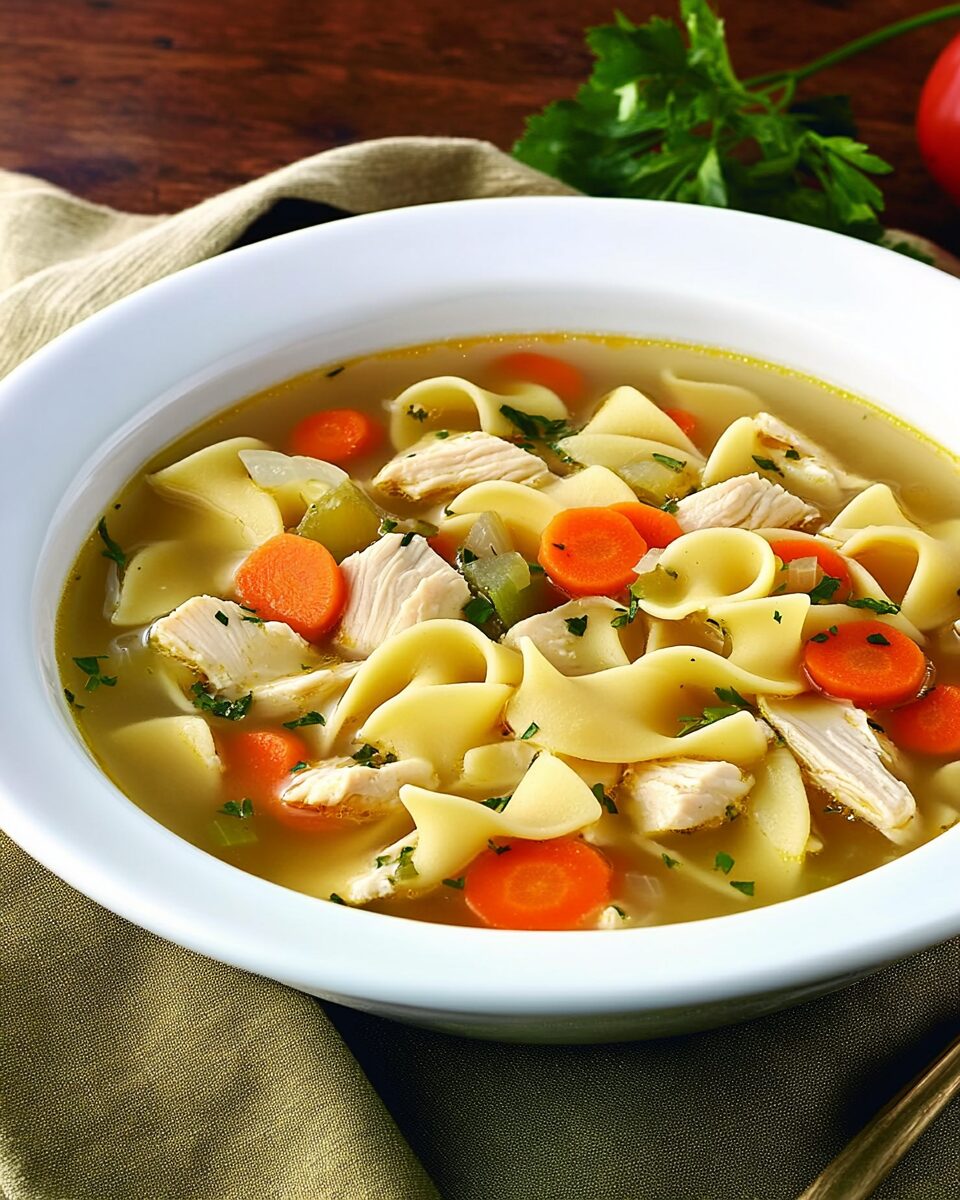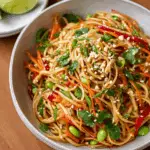The rich aroma of simmering chicken broth, tender carrots, and buttery egg noodles brings everyone to the table in no time. This timeless Chicken Noodle Soup with Egg Noodles is the perfect blend of simplicity and nourishment, offering comfort in every spoonful. Whether you’re fighting off a cold or just looking for a wholesome dinner idea, this soup is a go-to choice for cozy nights.
Best of all, this recipe uses ingredients you likely already have in your kitchen. It’s easy to make, budget-friendly, and full of flavor. The egg noodles give the dish a rustic touch and a satisfying texture that elevates it beyond your average chicken soup. Perfect for meal prep, serving guests, or curling up with a warm blanket and a bowl, this soup is a must-have in your homemade recipe collection.
Full recipe:
Ingredients:
-
1 tablespoon butter
-
½ cup chopped onion
-
½ cup chopped celery
-
4 (14.5 ounce) cans chicken broth
-
1 (14.5 ounce) can vegetable broth
-
1½ cups chopped cooked chicken breast
-
1½ cups egg noodles
-
1 cup sliced carrots
-
½ teaspoon dried basil
-
½ teaspoon dried oregano
-
Salt and ground black pepper to taste
Directions:
-
In a large pot over medium heat, melt the butter.
-
Add onion and celery; cook and stir until just tender, about 5 minutes.
-
Pour in chicken broth and vegetable broth and bring to a boil.
-
Stir in the chicken, noodles, carrots, basil, oregano, salt, and pepper.
-
Reduce heat and simmer for 20 minutes, until noodles and vegetables are tender.
Prep Time: 10 minutes | Cooking Time: 30 minutes | Total Time: 40 minutes
Kcal: 180 kcal | Servings: 6 servings
Why Chicken Noodle Soup Is a Timeless Classic
There are few meals as universally loved and recognized as chicken noodle soup. Across the world, many cultures have their version of chicken-based broth soups, but the American-style chicken noodle soup—especially the kind made with wide, curly egg noodles—has become iconic in its own right.
The dish likely rose to popularity in the early 20th century, combining the health benefits of chicken with the satisfaction of pasta, all enveloped in a rich, savory broth. During times of illness, chicken noodle soup has long been prescribed as a home remedy—both scientifically supported and emotionally comforting. In fact, the amino acids released from simmering chicken have been shown to help reduce inflammation and boost immune function. Paired with vegetables and warm broth, the result is more than food—it’s therapy in a bowl.
The Role of Egg Noodles in This Dish
While pasta varieties can vary widely, there’s something special about egg noodles in chicken soup. Their unique texture—soft yet resilient—soaks up the broth while retaining just the right amount of chewiness. They’re richer than standard pasta due to the inclusion of eggs in the dough, which gives the soup a heartier feel.
Egg noodles originated in Eastern European cuisine but quickly became a staple in American cooking, especially in dishes where texture plays a key role. In chicken noodle soup, they don’t merely complement the broth—they enhance it. Their ability to hold flavor makes every bite more satisfying, turning a light soup into a filling meal.
Nutrition and Comfort in One Bowl
Chicken noodle soup isn’t just flavorful—it’s also a nutritionally balanced meal. It combines lean protein from chicken, carbohydrates from egg noodles, and a variety of vitamins and minerals from vegetables like carrots, celery, and onions. The broth, particularly if homemade, can be rich in collagen and electrolytes, making it hydrating and restorative.
This dish is low in calories yet deeply satisfying. It’s a smart choice for people watching their intake but still seeking something comforting. For those recovering from illness or surgery, it provides easily digestible nutrients without overwhelming the digestive system. It’s also a go-to choice during cold and flu season, not just because of tradition, but because it truly helps.
The Emotional and Cultural Connection
Few dishes stir as much emotion as chicken noodle soup. It’s often one of the first “real” meals we’re given as children when we’re sick. It’s the meal that parents prepare with love, bringing a sense of security and healing. It’s made in big batches, often enough to feed an entire family, evoking feelings of warmth and togetherness.
From holiday gatherings to simple weeknight dinners, chicken noodle soup plays a recurring role in our lives. It’s served in nursing homes, schools, and high-end restaurants alike, proving that simplicity often wins. For many, just the aroma of it simmering on the stove is enough to bring back memories of childhood, of being cared for, of home.
Modern Takes and Variations
While the traditional version remains untouched in many kitchens, modern foodies and chefs have started to experiment with the classic chicken noodle soup. Some add a spicy twist with chili flakes or ginger. Others swap egg noodles for gluten-free alternatives like rice noodles or spiralized vegetables. There are also vegetarian versions that mimic the deep umami flavor of chicken broth using mushrooms, miso, and root vegetables.
For those who want to elevate the soup, garnishes like fresh parsley, a squeeze of lemon, or a sprinkle of Parmesan cheese can add layers of flavor. Using homemade broth instead of store-bought also transforms this humble soup into something restaurant-worthy.
Chicken Noodle Soup in Global Cuisines
Although the American version with egg noodles is perhaps the most recognized in the West, other cultures have equally beloved variations. In Jewish cuisine, matzo ball soup shares the same soul-soothing qualities. In Asia, chicken-based noodle soups like pho or ramen offer their own regional flair. Greek avgolemono adds egg and lemon to the mix, creating a tangy, creamy version of chicken soup.
This adaptability across cultures speaks volumes about its versatility. No matter where you are in the world, there’s likely a chicken soup that holds special meaning. The American-style egg noodle version is just one delicious chapter in this global story.
How to Serve and Store Chicken Noodle Soup
When serving chicken noodle soup, presentation can elevate the experience. A deep bowl, a sprinkle of fresh herbs, and a slice of crusty bread on the side are all you need. This soup also pairs well with simple sides like a garden salad or grilled cheese sandwich for a more complete meal.
It stores beautifully, making it a favorite for meal preppers and busy families. You can refrigerate it for up to four days or freeze it for up to three months. However, when freezing, it’s best to keep the noodles separate and add them fresh during reheating to prevent them from becoming mushy.
A Great Starter or a Standalone Meal
Depending on the portion size, chicken noodle soup can work as a light appetizer or a hearty main course. A small bowl might precede a roasted chicken or pasta dinner, while a larger portion—filled with extra veggies or shredded chicken—can serve as a satisfying lunch or dinner all on its own.
Its balance of protein, vegetables, and carbs makes it well-rounded, and its warm, comforting profile makes it suitable for all ages and dietary preferences (with some slight adjustments if needed). This flexibility is another reason why it has stood the test of time in countless kitchens.
Conclusion: More Than Just a Soup
Chicken noodle soup with egg noodles isn’t just a recipe—it’s an experience. It’s the dish we turn to when we need comfort, when we want to show care, or when we simply crave something soulful. From its nourishing ingredients to its deep cultural roots, this classic soup continues to bring people together around the table.
Its adaptability ensures it will remain relevant for generations to come. Whether enjoyed in a bustling household, served at a quiet dinner for one, or prepared lovingly for a sick loved one, chicken noodle soup offers far more than flavor. It offers warmth, healing, tradition, and love—all in a single bowl.






